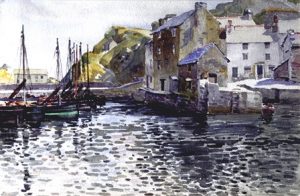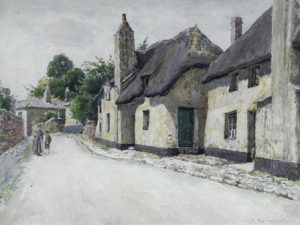Whanganui Artists
Left – Violet Whiteman, Fox Hunting, oil on canvas. Collection of the Sarjeant Gallery Te Whare o Rehua Whanganui. Gift, 1990. Right – Charles Howorth, The Whanganui River, circa 1910 oil on canvas. Collection of the Sarjeant Gallery Te Whare o Rehua Whanganui. Gift, 1927
Whanganui Artists
Dr Pamela Gerrish Nunn is an art historian currently researching New Zealanders working in the famous art colonies of Cornwall, south-west England, from 1880 to 1960. Her research has led her to Whanganui and the Sarjeant Gallery, but she needs our help!
The Sarjeant Gallery can tell Wanganui people a lot about the artists the town has nurtured over the years. One of its missions, when it first opened its gracious doors nearly a century ago, was to honour its local artists and ensure that Wanganui would not be lacking a cultural aspect which would bear comparison with any other town of similar size in the country. The Gallery, the Technical School, the Arts and Crafts Society, combined ultimately to form a creative hub which established Wanganui on the artistic circuit of New Zealand, attracting attention from other centres such as Christchurch, Wellington, Nelson and Dunedin. Nowadays, it is widely agreed that the Sarjeant’s name guarantees a high quality experience of art, history and civic pride.
Furthermore, it still has stories to tell and curiosities to reveal: deep in the Sarjeant’s collections sit the creative efforts of many an artist now unknown, forgotten, or perhaps simply out of date whose life’s work has yet to be displayed to their current townspeople.
So there are some gaps, too, in the Gallery’s account so far of the town’s cultural history: holes in the chronology and in individual histories which could be plugged by the paintings and drawings and, perhaps, letters, diaries, photos or other ephemera treasured by local people whose personal connections with the town and surrounding area go back several generations.

Dennis Seaward, Untitled (Harbour Scene), Watercolour on card. Collection of the Sarjeant Gallery Te Whare o Rehua Whanganui. Gift, 1972

Charles Hay-Campbell, Thatched Cottages,Watercolour on paper. Collection of the Sarjeant Gallery Te Whare o Rehua Whanganui. Gift, 1994.
Nunn is keen to hear from anyone who has something to tell about Denis Seaward (1876-1946), who came to Wanganui from England in 1908 to head the Art Department of the Technical School, and in 1908 designed a new certificate for successful students of the college; he was in the first batch of Wanganui soldiers to be called up in 1917, and on return resumed his job until 1921; at that point he left the town for good, serving as the Principal of the Falmouth College of Art (Cornwall) until 1940.
Charles Hay Campbell (1867-1936), a Scotsman who came to Wanganui in 1915 to take up a position at the Wanganui Collegiate School, as it was termed then; who was the first chairperson of the Arts and Crafts Society when it was formed in 1919, and the joint curator of the opening show at the Sarjeant when it opened that same year, and a painter to the end of his life
Violet Whiteman (1873-1952) who came to this country from England in 1926; she and her husband settled near Wanganui, and she became known as one of this country’s foremost animal painters, attracting the nickname “New Zealand’s Bonheur”, after the famous French 19th-century animal-painter Rosa Bonheur.
Charles Howorth (1856-1945), who came to live in Wanganui about 1912, becoming in due course an early member of the Arts and Crafts Society; he painted all his life, specialising in landscape, and was a regular fixture in the regional art society exhibitions. If you can provide any information that may be of assistance, please contact (Dr) Pamela Gerrish Nunn; gerrish.nunn@orcon.net.nz



